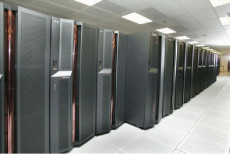NERSC-ANL Blue Planet Proposal Serves as Blueprint for ASCI Purple
March 3, 2004

ASCi Purple, installed at LLNL, was derived from the Blue Planet proposal developed by Lawrence Berkeley and Argonne national labs.
Two separate events, both aimed at dramatically advancing scientific computing and announced within a month of each other in late 2002, converged in 2003 and will result in DOE’s leadership in high-performance computing for years to come. The first step was the publication in October 2002 of an idea often referred to as “Blue Planet." A month later, DOE announced that IBM had been selected to build ASCI Purple, the fifth generation ASCI supercomputer for the stockpile stewardship program.
Here’s a look at how an idea that originated in the Office of Science laboratories has crossed over to help strengthen a program in NNSA.
In 2002, computing leaders from Lawrence Berkeley and Argonne national laboratories, in close collaboration with IBM, developed a bold proposal to re-establish the United States as the clear leader in high-performance computing. Entitled “Creating Science-Driven Computer Architecture,” the proposal called for moving away from dependence on hardware that is designed and optimized for commercial applications and to create a new class of computational capability in the United States that is optimal for science.
This comprehensive strategy includes development partnerships with multiple vendors, in which teams of scientific applications specialists and computer scientists will work with computer architects from major U.S. vendors to create hardware and software environments that will allow scientists to extract the maximum performance and capability from the hardware. The proposal recommended pursuing three different options to determine the best price-performance in a scientific computing environment.
The second option called for using commercial microprocessors in a new architecture known as ViVA or Virtual Vector Architecture. In this option, IBM would partner with Lawrence Berkeley National Laboratory to implement early versions of this architecture and deliver Blue Planet, a 160 teraflop/s mature implementation in the second half of 2005.
To create Blue Planet, LBNL would work with IBM to enhance IBM’s current Power 5 plan in order to deploy a system with approximately 150 Tflop/s peak performance that will be able to sustain 40 to 50 Tflop/s sustained performance on at least several real scientific codes. Each of the 2,048 nodes will consist of eight "single core" CPUs that provide double the memory bandwidth of the standard Power 5 CPUs and will have their own dedicated L1, L2, and L3 caches. The CPUs will have a peak performance of roughly 8–10 Gflop/s.
The architecture caught the attention of ASCI managers at Lawrence Livermore National Laboratory who were working with IBM to design and build ASCI Purple. This system is expected to provide DOE with the world’s first supercomputer capable of up to 100 teraflop/s, more than twice as fast as the most powerful computer in existence today.
When the final architecture of ASCI Purple was agreed upon, it was designed around the eight-way node originally proposed for Blue Planet. As a result, the system is expected to be less expensive than originally expected, as well as more effective for carrying out its intended mission.
“We owe you a debt of gratitude for conceiving the eight-way node with IBM and pushing so strongly for it with IBM,” wrote Michael McCoy of LLNL when informing NERSC Center General Manager Bill Kramer of the ASCI Purple decision. “This is a clear example of ASCI benefiting from Office of Science ‑ and NERSC in particular ‑ working the system for better solutions for science. Also, the cost of the system is much lower than the original thanks in part to the new node.”
The ASCI Purple contract calls for the 12,544-processor system to be installed at Lawrence Livermore by 2005.
“We all owe NERSC thanks for vision and energy in this singular effort,” McCoy continued. “I hope that in the future that you can build a machine from this building block with your virtual vector solution included - but even if this does not come to pass and you go with some other solution that you deem preferable at that time, you certainly did us a great favor, and it will not be forgotten.”
About NERSC and Berkeley Lab
The National Energy Research Scientific Computing Center (NERSC) is a U.S. Department of Energy Office of Science User Facility that serves as the primary high performance computing center for scientific research sponsored by the Office of Science. Located at Lawrence Berkeley National Laboratory, NERSC serves almost 10,000 scientists at national laboratories and universities researching a wide range of problems in climate, fusion energy, materials science, physics, chemistry, computational biology, and other disciplines. Berkeley Lab is a DOE national laboratory located in Berkeley, California. It conducts unclassified scientific research and is managed by the University of California for the U.S. Department of Energy. »Learn more about computing sciences at Berkeley Lab.







